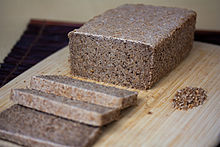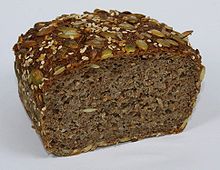|
Sprouted bread
Sprouted bread is a type of bread made from whole grains that have been allowed to sprout (i.e., to germinate before being milled into flour). There are a few different types of sprouted grain bread. Some are made with additional added flour; some are made with added gluten; and some, such as Essene bread and Ezekiel bread (after an ancient bread formula found in the Tanakh in Ezekiel 4:9 or, according to others, Ezekiel 4:15) are made with very few additional ingredients. Overview Sprouted breads contain the whole, sprouted grain (the kernel, or berry) of various seeds. They are different from white bread inasmuch as white breads are made from ground wheat endosperm (after removal of the bran and germ). Whole grain breads include the bran, germ, and endosperm, therefore providing more naturally occurring fiber, vitamins and proteins. Sprouted (or germinated) grain breads have roughly the same amount of vitamins per gram, and 47% less gluten than regular bread.[citation needed] A comparison of nutritional analyses shows that sprouted grains contain about 75% of the carbohydrates, slightly higher protein and about 40% of the fat when compared to whole grains.[1][2] In addition to wheat, sprouted breads may contain grains and legumes, such as millet, barley, oat, lentil and soy. Bread that is made from an array of grains and legumes can provide a complete set of amino acids, the building blocks of proteins. Sprouted breads may contain slightly more trace minerals and nutrients than non-sprouted breads. Other than that, they supply much the same advantages as whole grain breads over refined grain breads, such as lowered risk of coronary heart disease.[3] Essene bread Essene bread is a simple form of sprouted grain bread made from sprouted wheat and prepared at a low temperature. Proponents of raw foods often eat it uncooked or slightly heated.[4][5] The Essenes, an ascetic Jewish sect that flourished from the second century BCE through the first century CE, are credited with the technique and basic recipe for Essene bread[6] despite a dearth of scholarly evidence for the claim. Sprouting and low-temperature preparation ensures the maximum possible vitamin content for the foodstuff.[6] Sprouting also breaks down the lectins and other substances that some individuals may be sensitive or allergic to.[6] See also
References
|
||||||||||

